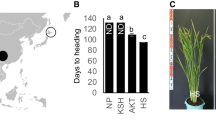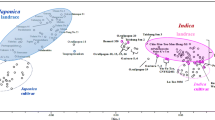Summary
The pedigrees of 99 Japonica rice (Oryza sativa L.) varieties released between 1940 and 1987 were traced back to 65 ancestors, of which 44 were plant introductions from Japan and only 11 from Taiwan. Japanese introductions collectively contributed more than 85% of the parentage of the varieties. Although more ancestors were integrated into recent breeding programs, as few as 10 ancestors comprised 66% of the genetic background. Extensive use of superior genotypes from the same sources explained why the integration of new germplasm did not result in the diversification of the released varieties. The 10 most important ancestral contributors of the 99 varieties were from Japan except ‘Oloan-chu’ from Taiwan. Two introductions, ‘Sinriki’ and ‘Kameji’, had the highest mean relative genetic contributions of the genes with 21.3% and 16.7%, respectively. Shinriki was the most frequently used ancestor and occurred in 83 of the 99 pedigrees. These results clearly revealed the narrow genetic base in current Japonica rice varieties of Taiwan.
Similar content being viewed by others
References
Chang T.T., 1984. Conservation of rice genetic resources: luxury or necessity? Science 224: 251–256.
Chang T.T., C.R. Adair & T.H. Johnston, 1982. The conservation and use of rice genetic resources. Adv. Agron. 35: 38–91.
Cox T.S., J.P. Murphy & D.M. Rodgers, 1986. Changes in genetic diversity in the red winter wheat regions of the United States. Proc. Natl Acad. Sci. USA. 83: 5583–5586.
Delannay X., D.M. Rodgers & R.G. Palmer, 1983. Relative genetic contributions among ancestral lines to north American soybean cultivars. Crop Sci. 23: 944–949.
Huang, C.S., 1987. Genetic ancestry of important rice varieties and utilization of rice germplasms. In: S.C. Hsieh (Ed.), Crop exploration and utilization of genetic resources. Taiwan Provincial Taichung District Agricultural Improvement Station, pp. 233–246.
Knauft D.A. & D.W. Gorbet, 1989. Genetic diversity among peanut cultivars. Crop Sci. 29: 1417–1422.
Souza E. & M.E. Sorrells, 1989. Pedigree analysis of north American oat cultivars released from 1951 to 1985. Crop Sci. 29: 595–601.
St Martin S.K., 1982. Effective population size for the soybean improvement program in maturity groups 00 to IV. Crop Sci. 22: 151–152.
Wright S., 1922. Coefficients of inbreeding and relationship. Amer. Nat. 56: 330–338.
Author information
Authors and Affiliations
Rights and permissions
About this article
Cite this article
Lin, M.S. Genetic base of Japonica rice varieties released in Taiwan. Euphytica 56, 43–46 (1991). https://doi.org/10.1007/BF00041742
Received:
Accepted:
Issue Date:
DOI: https://doi.org/10.1007/BF00041742




